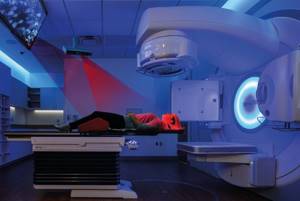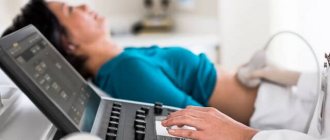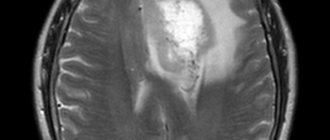In modern medicine, magnetic resonance imaging is considered the standard of diagnosis, making it possible to detect a wide range of pathologies of internal organs.
Patients are prescribed MRI at the stage of initial examination and diagnosis confirmation, before and after surgical interventions, as well as for the prevention of oncology and other diseases.
The method is highly informative, but has a number of implementation features and requirements for patients, and this must be taken into account.
One of the issues that particularly concerns patients is the possibility of drinking alcohol before the procedure. Any doctor will answer that it is impossible, but is this really so, and why is it so important that there are no ethanol breakdown products in the body at the time of diagnosis? Let's figure it out.
No. 2. In what cases should an MRI of the hip joint not be performed?
There are absolute contraindications to this examination. It is not performed if you have a pacemaker and an electronic middle ear implant. The magnetic field of a tomograph can disable them and cause irreparable harm to health, as well as create a threat to life.
An MRI is contraindicated if a person already has large metal implants, including joint replacements, such as in the knee, artificial heart valves or implanted pumps, surgical staples, or any metal elements in the body, such as bullets or shrapnel. It is also abandoned if a compression-distraction device is installed, which fixes bone fragments. If there are clips on the brain vessels, which theoretically can rupture under the influence of the tomograph.
Pacemaker is an absolute contraindication for MRI
Radiation therapy: questions and answers
What happens in the body during irradiation?
Just like the human body, tumors are also made up of cells. Tumor growth is regulated by cell division. Irradiation is a “growth inhibitor” for living tissue. One of the main effects of radiation is to disrupt or prevent cell division. In particular, radiation affects the genetic material in the cell nucleus. The cell loses its ability to divide and, as a result, dies.
However, every cell has a regeneration system to repair such damage. The ability to regenerate is much more pronounced in healthy, normal cells than in tumor cells, so radiation affects the tumor much more severely than healthy tissue. Radiation therapy benefits from this difference in regenerative ability. However, the regeneration process in the incidentally irradiated surrounding tissue takes some time, so the total radiation dose is divided into several separate sessions (fractions).
Experience shows that in many cases daily exposure gives the best results. After successful irradiation, the tumor cells die, are broken down by the body's own cells and are eliminated from the body.
How long does radiation therapy last?
Each individual radiation therapy session lasts only a few minutes. To successfully treat cancer, multi-week treatment, 5 days a week, is often necessary. In this case, the weekend remains free.
What rays are actually used?
Our treatment devices produce so-called electronic and photon radiation with different energies, which affect the human body from the outside.
Will I spread radiation after exposure?
No. When irradiated at a linear accelerator, you yourself do not distribute the radiation in any way.
Will I feel the radiation? Will I experience pain?
No. As with x-ray diagnostics, you will not notice the radiation itself.
What side effects does radiation therapy have?
In general, radiation is well tolerated. However, side effects may occur, which mainly depend on which area of the body you are exposed to. Our doctors will explain to you how high the likelihood of side effects will occur and what kind of side effects you can expect during your first consultation at our outpatient clinic or department. We will also tell you how, together with you, we can mitigate side effects and which ones.
What should I do if side effects occur?
Please report any possible side effects to your radiology medical technician or your doctor. There are many interventions and medications available to alleviate these side effects.
Can skin burns occur due to radiation?
In most cases of radiation therapy, there are virtually no skin reactions. If the skin is deliberately incidentally irradiated or should be irradiated, redness of the skin may occur, as well as partial superficial peeling and tanning, as with a sunburn. These reactions subside within a few weeks after completion of radiation therapy.
How should I care for my skin during a series of radiation treatments?
During your first consultation, you will receive information on skin care. During our weekly medical consultations, possible skin reactions will be monitored and, if necessary, treatment recommendations will be discussed.
Can I wash myself?
Yes, however, this possibility is limited. Due to irradiation, the skin in the irradiated area may become sensitive and therefore require gentle, gentle care. Your doctor will give you information regarding skin care.
If your skin has radiation markings, you must ensure that they do not disappear during showering or bathing. If this happens, please notify a member of staff at your practice and under no circumstances attempt to apply the markings yourself.
Do I have to have an accompanying person accompany me to my daily exposures?
In most cases, there is no need for the help of an accompanying person, but his presence facilitates the treatment process and helps overcome fear, at least in the first days of radiation. It is the elderly who feel more confident in the presence of an accompanying person, especially in the first days of irradiation, remember the route better and quickly understand the treatment process.
Why is another computed tomography (CT) scan necessary?
Computed tomography for radiation planning, which is performed using special devices to position the patient on the table, allows you to create exactly the same conditions as later during radiation. This is the only way to plan and carry out therapy very accurately. Therefore, previously taken computed tomography images are unsuitable for radiation planning.
Should I follow a special diet?
There is no need to diet, but if you have radiation exposure to the face and neck or radiation exposure to the chest area (for example, for lung or esophageal cancer), you should avoid foods that are high in acid and spices. This also applies to drinks that contain fruit acid or alcohol.
When irradiating the abdominal and pelvic area (for example, the colon and prostate gland or gynecological abdominal irradiation), foods that cause flatulence and very fatty foods should be avoided. In general, a balanced diet and carefully prepared food are recommended.
When irradiating the prostate gland, it is also necessary to ensure that the bladder is sufficiently full at each treatment session (both on the planning day and on the day of irradiation). Therefore, drink plenty of fluids approximately 30 to 60 minutes before each appointment and do not empty your bladder again immediately before radiation.
How appropriate is it to take vitamins and nutritional supplements?
There is no mandatory need to take vitamins or nutritional supplements during radiation therapy. However, there is nothing wrong with taking a multivitamin. Taking certain vitamins, such as vitamin A, C or E, is not recommended, as they may have a negative effect on the effects of radiation. The effects of nutritional supplements such as enzymes or selenium are unproven.
Can I play sports and continue to be involved in my professional activities?
It is possible that during treatment you will not have to give up sports activities and you will be able to live your normal daily life. Moderate mobility, such as walking, is especially beneficial. Calmly do everything that brings you pleasure, and give up anything that is associated with mental or physical overload.
Visiting a solarium and sunbathing during or after radiation therapy.
In principle, irradiated fields should not be exposed to additional ultraviolet radiation during treatment and for 6 months after it. This means that these areas of skin must be protected from light or covered during a beach holiday, for example.
Visit to the hairdresser.
You can safely visit the hairdresser. However, when irradiating the head and neck area, please refrain from dyeing your hair or rubbing in substances containing alcohol. In general, it is possible to wash your hair, for example, once a week. Please use a mild shampoo (eg baby shampoo).
Can I interrupt the series of exposures in case of important events?
To avoid tumor cell recovery and regrowth, your radiation therapy should not be interrupted.
In rare cases, it may be necessary to interrupt treatment to allow time for significant side effects to subside.
Is the first radiation treatment given immediately after an outpatient appointment?
No. A planning CT scan and careful planning of the radiation treatment are usually necessary first, so that the first radiation exposure may not occur until a few days after the planning CT scan.
Does hair fall out during radiation therapy?
Hair on the scalp only falls out if the scalp area is irradiated. Typically, hair loss is only a temporary phenomenon. We will be happy to help you if you need a wig during this time.
Can I drink alcohol or smoke during a series of radiation treatments?
There is no objection to occasionally enjoying a glass of wine or beer, unless the radiation is administered to the oral cavity or esophagus. You should completely avoid drinking strong alcoholic drinks, as this can increase possible side effects. Smoking is fundamentally harmful to your health. In addition, it increases the risk of developing cancer (primarily cancer of the lung, larynx and esophagus). We strongly advise you not to smoke.
What is visible in the control photographs taken during treatment?
Control images show whether the radiation has completely covered the entire desired area, and whether a slight adjustment may be necessary regarding the position of the patient (on the radiation table). The images show bones and lungs, but these images cannot tell whether the tumor has shrunk or disappeared.
Can irradiation be given multiple times?
Repeated irradiation is usually possible, but only to a different area. Whether radiation can be given to the same area depends, among other things, on the dose of previous radiation and surrounding organs. If you have already been exposed to radiation, you should always discuss this with your doctor.

No. 7. How is the procedure done? It does not hurt?
The patient is positioned in the tomograph. The procedure takes about half an hour and does not cause pain. During this time, the patient with suspected coxarthrosis should remain motionless. This is the main difficulty for many. You may feel a slight warmth at the site of exposure.
During the procedure, the laboratory assistant is in the adjacent room, controls the tomograph, but constantly communicates with the patient through the communication system. The results will be ready the next day.
This is what a tomograph for MRI of the hip joint looks like
No. 10. What are the health risks after undergoing an MRI?
If all conditions are met, the risks are minimal. If there are implants in the body that the patient has not informed the doctor about, they may change location and lose functionality. This condition is life-threatening. There is also always the possibility of developing allergic reactions to contrast. Otherwise, the risks are not high if the examination is carried out by a qualified specialist.
What diseases can be seen in the hip joint using MRI? About this and much more in the video below:
For hip diseases, MRI is an excellent alternative to a painful biopsy. In terms of performance, she has no equal. The examination does not cause discomfort to the patient and does not have a negative effect on the body, since it does not use ionizing radiation. Magnetic resonance therapy has wide diagnostic capabilities, allowing the doctor to make the diagnosis as accurately as possible and prescribe effective treatment.
Is it possible to have an MRI after drinking alcohol?
The ban on alcohol before magnetic resonance imaging is associated with some features of the effect of alcohol on the body, such as:
- dilation of blood vessels, and after a certain period their narrowing;
- increased load on the heart;
- change in behavior, lack of coordination of movements, aggressiveness;
- decreased functionality of the liver and kidneys;
- disruption of nerve patency;
- general deterioration of health.
If you drink vodka, beer, cognac, etc. before an MRI, then, firstly, problems may arise with ensuring the patient’s immobility inside the tomograph, and secondly, the results will be blurry, because the vessels will not adequately reflect the magnetic field signals.
If an abdominal scan is planned, doctors often prescribe medications with which ethanol can react, causing a sharp deterioration in the condition.










